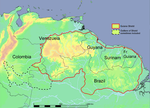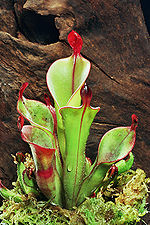sometimes considered part of the Chimantá Massif. The major tepuis of the northern and southern parts of the Chimantá Massif are listed below. Coordinates...
10 KB (935 words) - 00:30, 15 May 2023
Gran Sabana (section Chimantá Massif)
helicopter, as there are no vehicle access routes to the tepui. The Chimantá Massif is the formation of plateaus (10 in total, among which Amurí, Churí...
36 KB (4,966 words) - 06:02, 26 October 2024
Distribution of Heliamphora (section Chimantá Massif)
native to the eastern range, which includes the Aprada Massif, Auyán Massif, Chimantá Massif, Eastern Tepuis chain, Los Testigos chain, and a number...
55 KB (3,217 words) - 18:44, 5 September 2022
(9,826 ft). Pico da Neblina is the highest summit of the larger Neblina massif, a highly eroded sandstone plateau that straddles the Venezuela-Brazil border...
14 KB (1,308 words) - 13:47, 27 October 2024
ecosystem composed of unique plant and animal species at the bottom. Ilú-Tramen Massif is the most northerly mountain in the chain that stretches along the Venezuelan-Guyana...
15 KB (1,600 words) - 14:28, 27 September 2024
pitcher plant endemic to the Chimantá Massif in Venezuela. Specifically, it has been recorded from Apacará and Chimantá Tepuis. It is thought to be more...
3 KB (314 words) - 08:22, 9 January 2024
Anomaloglossus rufulus (redirect from Chimantá poison frog)
is endemic to Venezuela where it is known from a few tepuis in the Chimantá Massif in the Bolívar state. Males measure 20.4–22.4 mm (0.80–0.88 in) and...
4 KB (312 words) - 07:39, 2 September 2022
Heliamphora huberi is a species of Marsh Pitcher Plant endemic to the Chimantá Massif in Venezuela, where it grows at elevations of 1850–2200 m in a variety...
2 KB (156 words) - 19:38, 27 October 2022
Aprada-tepui (redirect from Aprada Massif)
Aprada-tepui lies 22 kilometres (14 mi) northwest of the much larger Chimantá Massif and around 25 km (16 mi) east of the Pemón village of Urimán. Aprada-tepui...
4 KB (318 words) - 15:28, 3 July 2023
the vast Chimantá Massif, from which they are separated by the Río Aparurén valley. Amurí-tepui, the closest member of the Chimantá Massif, is only 8...
4 KB (417 words) - 01:19, 5 October 2023
peak, both it and nearby Angasima-tepui lie just south of the vast Chimantá Massif, from which they are separated by the Río Aparurén valley. Upuigma-tepui...
3 KB (305 words) - 04:32, 27 September 2024
Bolivar State in Venezuela. Scientists have seen it near summits in the Chimantá Massif, between 1800 and 2600 meters above sea level. The adult male frogs...
2 KB (248 words) - 14:48, 16 October 2024
Ayanganna, Mount Wokomung) and in the Bolívar state in eastern Venezuela (Chimantá Massif, Cerro Jaua, Mount Roraima). This relatively common frog is a diurnal...
4 KB (361 words) - 17:26, 11 March 2023
undisturbed ecosystems. The genus is almost entirely restricted to the Chimantá Massif, a complex of several of these tepuis in Bolívar, Venezuela. There...
3 KB (271 words) - 07:13, 2 September 2022
species of lizard in the family Gymnophthalmidae. It is endemic to Chimantá Massif in Venezuela. It is named for Roy W. McDiarmid, American herpetologist...
2 KB (121 words) - 23:39, 25 October 2024
the Chimantá tepui. This species is named after its type locality which is Chimantá Tepui, Bolívar, Venezuela. Also called Thermodynastes chimanta. D....
4 KB (312 words) - 11:50, 3 July 2024
Range and higher tepuis (Monte Roraima, Kukenan, Cerro Marahuaca, Chimantá Massif). This climate zone is present in towns like Mucuchíes, Chachopo and...
17 KB (1,985 words) - 02:27, 22 November 2024
wurdackii is a species of Prunus found only on the slopes of tepuis of the Chimantá Massif in Venezuela, at 900–2,200 m (3,000–7,200 ft) in elevation. Judging...
2 KB (227 words) - 16:04, 29 June 2024
pulchellus = pretty) is a species of marsh pitcher plant endemic to the Chimanta Massif and surrounding tepuis in Venezuela. It is one of the smallest species...
5 KB (417 words) - 19:12, 27 April 2024
species of frog in the family Hemiphractidae. It is endemic to the Chimantá Massif, Venezuela. Its natural habitats are humid rocky habitats on tepuis...
2 KB (189 words) - 12:43, 30 October 2024
collection from Serrania Guanay, and several collections from the Chimantá Massif. It grows as a rheophyte on wet sandstone cliffs near waterfalls among...
1 KB (115 words) - 01:54, 3 September 2022
Cerro de la Neblina (redirect from Neblina massif)
Neblina in Brazil and Sierra de la Neblina in Venezuela, is a sandstone massif located in the northern Amazon Basin. It is a tilted, heavily eroded plateau...
17 KB (2,127 words) - 16:24, 23 November 2023
H. & Schlögl J. 2010). "Additional notes on Orthalicidae from the Chimantá massif, Venezuelan Guayana, with descriptions of new species of Plekocheilus...
34 KB (2,954 words) - 14:44, 27 July 2024
H. & Schlögl J. (2010). "Additional notes on Orthalicidae from the Chimantá massif, Venezuelan Guayana, with descriptions of new species of Plekocheilus...
50 KB (3,830 words) - 23:34, 2 August 2024
H. & Schlögl J. (2010). "Additional notes on Orthalicidae from the Chimantá massif, Venezuelan Guayana, with descriptions of new species of Plekocheilus...
5 KB (406 words) - 11:46, 28 September 2024
Pristimantis (Amphibia, Craugastoridae) from Abakapá-tepui in the Chimantá massif, Venezuelan Guayana, and additions to the knowledge of P. muchimuk"...
10 KB (1,180 words) - 05:15, 8 July 2024
H. & Schlögl J. (2010). "Additional notes on Orthalicidae from the Chimantá massif, Venezuelan Guayana, with descriptions of new species of Plekocheilus...
17 KB (1,126 words) - 13:55, 9 January 2024
appendage) is a species of marsh pitcher plant native to the Chimantá and Aprada Massifs of Bolívar state, Venezuela. It was for a long time considered...
3 KB (305 words) - 19:32, 27 October 2022
dot}4H2O, a new hydrated aluminum phosphate-sulfate mineral from Chimanta massif, Venezuela: Description and crystal structure". American Mineralogist...
46 KB (2,907 words) - 13:48, 5 December 2023
also simply known as Guayana (English: Guiana) in Venezuela, is a large massif of approximately 441,726 km2 (170,551 sq mi) area, equivalent to 48.2% of...
8 KB (858 words) - 21:22, 9 August 2024















